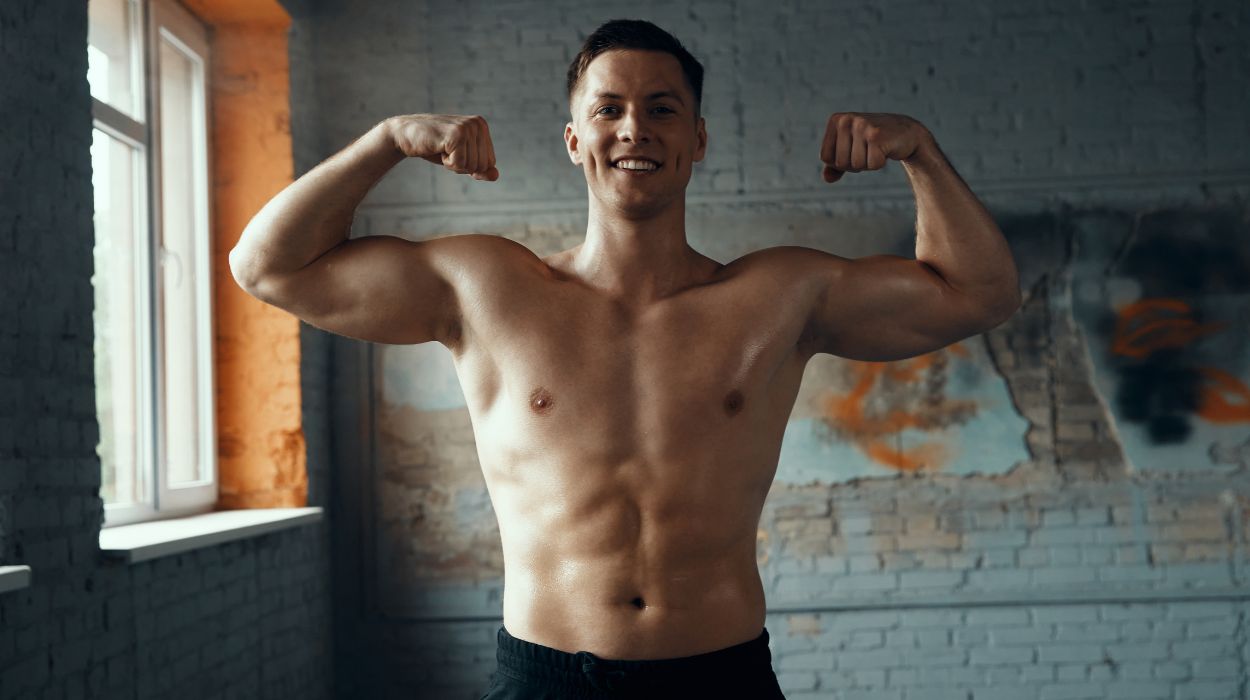
Building a strong upper body is more than just a fitness goal; it’s a journey toward a healthier, more empowered version of yourself. Focusing on your chest and shoulders can bring remarkable results.
A chest and shoulder workout can be tailored to your needs. From the comforts of home to the energy of the gym, these exercises can fit seamlessly into your lifestyle. These exercises include versatile movements like a lower chest workout. Transform your physique while boosting your confidence and strength.
Top Shoulder And Chest Workouts For Muscle Growth
For optimal muscle growth in your upper body, here are the five best chest and shoulder workouts to build your upper body:
- Seated Incline Dumbbell Press.
- Standing Barbell Military Press.
- Flat Bench Dumbbell Flyes.
- Standing Lateral Dumbbell Raises.
- Push-Ups.
This combination targets key muscle groups, ensuring a balanced and effective approach to building strength.
Chest And Shoulder Workouts To Build Your Upper Body
Building a strong upper body requires a blend of targeted exercises. Each workout mentioned here is designed to maximize muscle engagement, ensuring balanced development of both chest and shoulders.
Seated Incline Dumbbell Press
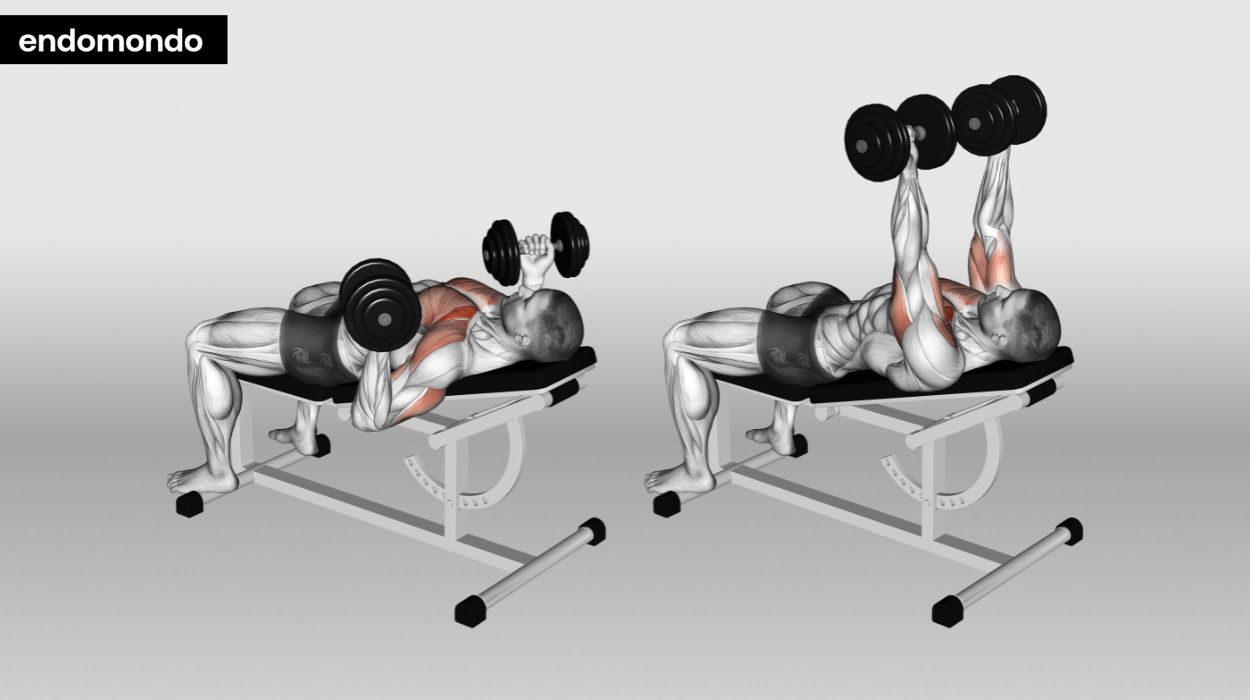
Imagine transforming your upper body with just one exercise. The Incline Dumbbell Chest Press does that – and more. It zeroes in on your upper chest, especially the pectoralis major.
Your shoulders and triceps? They’re not left out, either. This exercise is a game-changer, not just for bodybuilders but for anyone aiming to boost their upper body strength. It’s like giving your chest workouts at home with dumbbells a whole new level of intensity.
Plus, the incline adds a twist, making it one of the best exercises for the upper chest. More than just muscle-building, it enhances your daily pushing strength.[1] It is essential for daily activities and various sports.
Even something like opening heavy doors or pushing a stalled car can benefit from this exercise. Every rep is a step toward a stronger, more capable you. Perfect for your home routine, this exercise promises a blend of strength and aesthetic gains.
How to do:
- Set the Bench: Begin by adjusting your bench to an incline angle, typically between 30 and 45 degrees. This angle targets the upper chest effectively.
- Starting Position: Get in a good seated position on the bench with a dumbbell in each hand. Rest the dumbbells on your thighs as you lean back, then lift them to chest level.
- Overhand Grip and Elbow Position: Hold the dumbbells in an overhand grip with your palms facing forward. Keep your elbows at a 90-degree angle and in line with your shoulders as you start.
- Press Up: Exhale and press the dumbbells up above your chest. Extend your arms fully, but don’t lock your elbows. Keep the chest movements smooth and controlled.
- Lower with Control: Inhale as you slowly lower the dumbbells back down to the starting position. Ensure your elbows don’t drop below your shoulders to avoid strain.
Tips:
- Focus on slow, controlled chest movements.
- Breathe out while pushing up.
- Avoid locking your elbows at the top.
- Engage your core throughout the exercise.
- Start with lighter weights to perfect the form.
Optimal Sets and Reps: 3-4 sets of 8-12 reps.
Standing Barbell Military Press
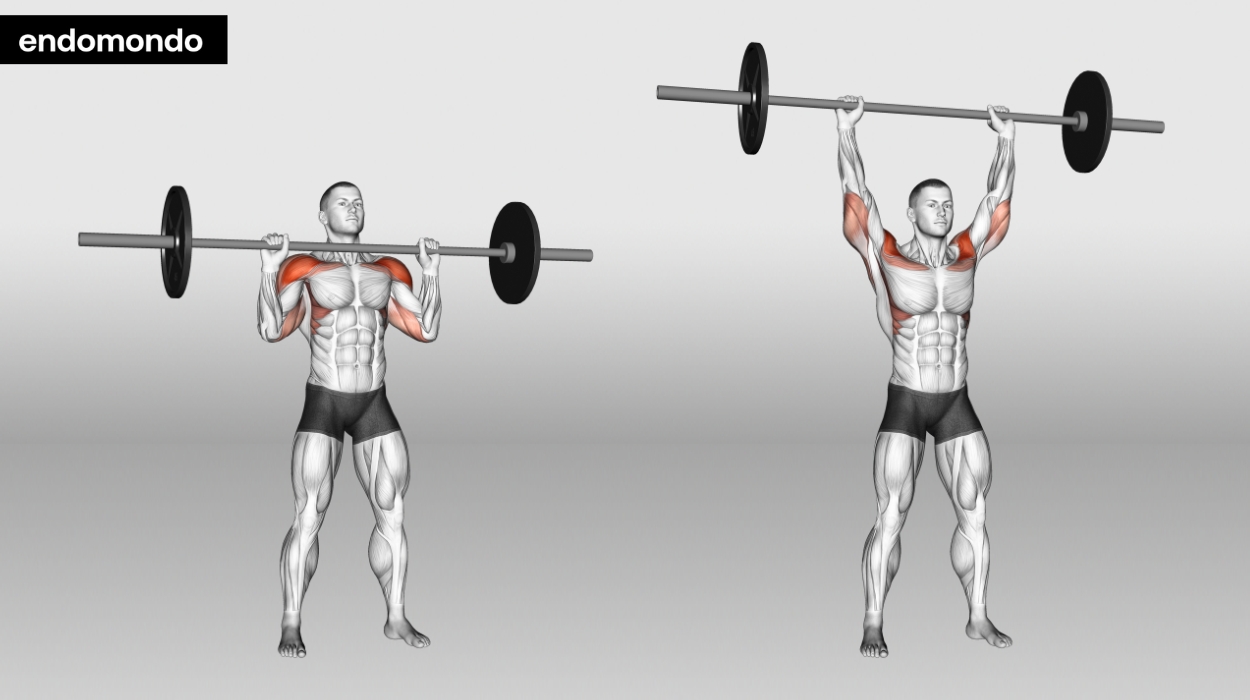
The Standing Barbell Military Press is a powerhouse for your shoulder workout, primarily hitting the deltoid muscles. Your triceps and upper back get in on the action too.
This isn’t just an exercise; it’s a full upper-body rally. And the benefits? They’re as real as the weights you lift.
Think about that satisfying burn, signaling muscle growth and a leap in functional strength. It’s ideal for anyone looking to amp up their dumbbell shoulder exercises. Each lift is more than a rep; it’s a step towards a more formidable, resilient you.
Get ready to press, lift, and transform.
How to do:
- Prepare Your Stance: Stand with your feet shoulder-width apart for a stable base. Keep your knees slightly bent to avoid locking them.
- Grip and Position the Bar: Grip the barbell slightly wider than shoulder-width. Lift it to just above your shoulders, positioning it in front of your neck. Your palms should be facing forward.
- Brace Your Core: Before you lift, tighten your abdominal muscles. This stabilization is crucial for protecting your spine during the lift.
- Press Upward: Exhale as you press the barbell up, extending your arms fully. Ensure the movement is smooth, and keep your arms straight, directly above your head.
- Controlled Lowering: Slowly lower the bar back to the starting position, just above the shoulders. Inhale as you do this, maintaining control and form throughout the movement.
Tips:
- Start with a weight that allows good form.
- Do not arch your back excessively.
- Keep your neck neutral.
- Engage your shoulders and arms, not just your back.
- Breathe in as you lower and out as you press.
Optimal Sets and Reps: 3-4 sets of 6-10 reps.
Flat Bench Dumbbell Flyes
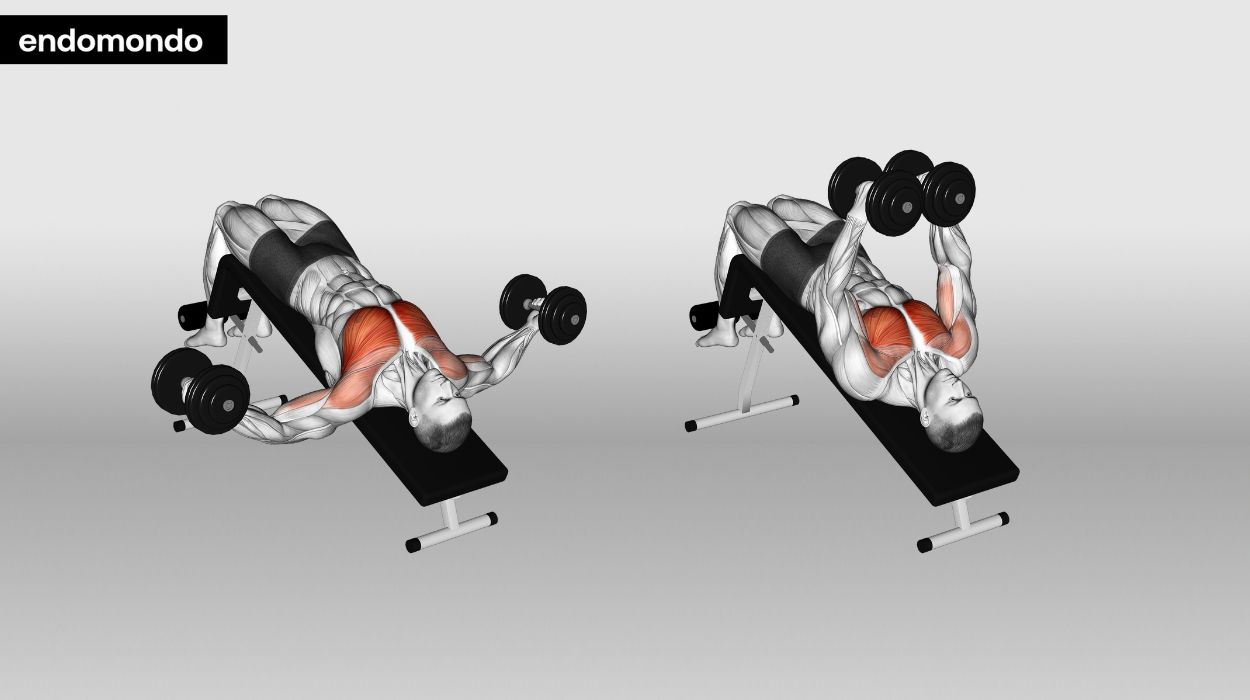
Dumbbell Flyes shine in chest and shoulder workouts. They have a unique way of working your chest muscles, especially the pectoral muscles. Imagine them stretching and contracting with each movement – it’s quite the experience for muscle development.
And it’s not all about the chest. Your shoulders and biceps join in, making it a full upper-body affair. You’re not just bulking up when you add the Dumbbell Chest Flye as a part of your regular chest workout routine. You’re shaping a balanced and visually appealing upper body.
What’s more, Dumbbell Flyes demand a level of control that’s great for your muscle stability and coordination.[2] Whether you’re powering through at the gym or fitting in a workout at home, Dumbbell Flyes are a standout choice for well-rounded fitness.
How to do:
- Set Up the Flat Bench: Begin by lying flat on a bench, holding a dumbbell in each hand. Your feet should be flat on the floor for stability.
- Arm Positioning: Start with your arms extended above your chest with a slight bend at the elbows. Your palms should face each other.
- Lower the Weights: Slowly lower the dumbbells out to the sides in an arc motion. Keep the bend in your elbows consistent throughout the movement.
- Controlled Descent: Continue lowering the dumbbells until they are level with your chest. Be mindful not to let them drop too low, as this can strain your shoulders.
- Lift and Squeeze: Bring the dumbbells back up in the same arc motion, squeezing your chest muscles at the top of the movement.
Tips:
- Avoid dropping your arms too low.
- Maintain a steady, controlled pace.
- Do not clank the weights together at the top.
- Engage your chest muscles throughout the movement.
- Use a weight that challenges but doesn’t strain.
Optimal Sets and Reps: 3-4 sets of 10-15 reps.
Standing Lateral Dumbbell Raises
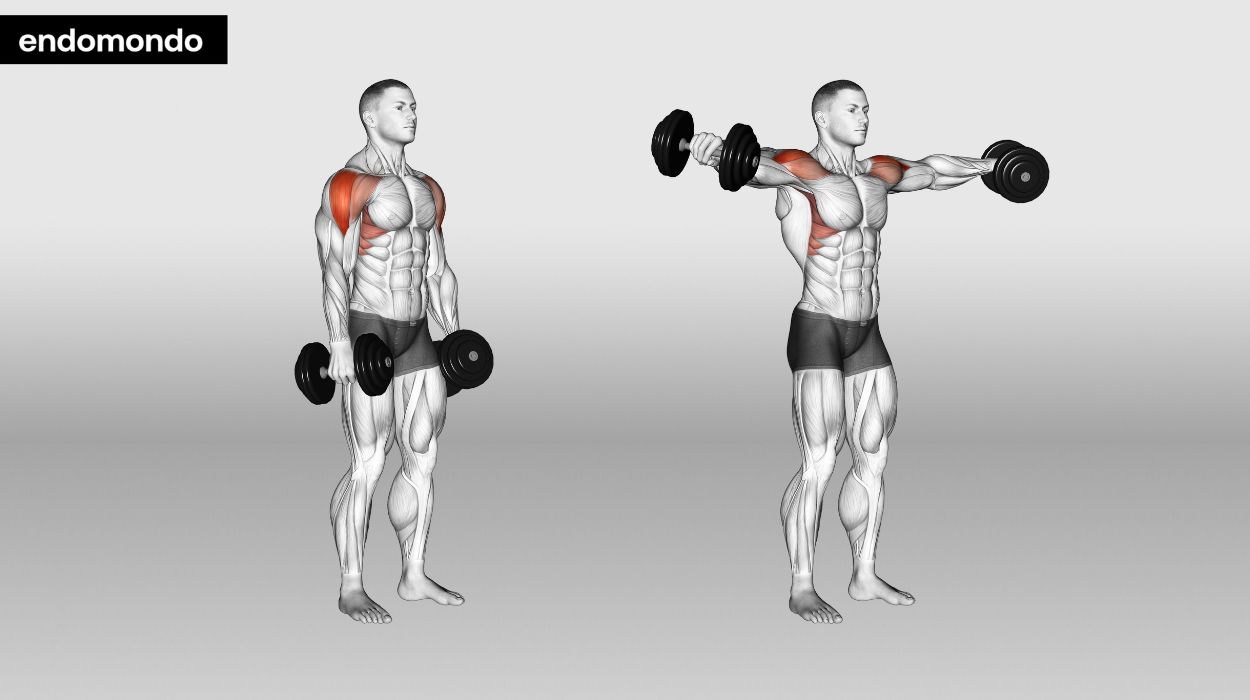
Lateral Dumbbell Raises are a hidden gem in shoulder-chest workouts. They specifically target the deltoids,[3] the shoulder’s crowning muscles. When done correctly, these raises sculpt your shoulder’s contour, enhancing that sought-after V-shape.
But their benefits extend beyond aesthetics. They also fortify your shoulder joints, boosting overall mobility and stability. This makes them a key player not just in gym routines but in everyday life.
Whether you’re reaching for a high shelf or swinging a tennis racquet, the strength you build here makes a difference. Integrating lateral raises into your routine, perhaps as part of a push-day workout routine, promises visible gains and functional ones. They’re straightforward yet effective, a perfect blend for anyone seeking a balanced upper body workout.
How to do:
- Starting Position: Stand with your feet hip-width apart, holding a dumbbell in each hand at your sides. Your palms should be facing your body, and your spine should be straight.
- Raise with Control: Slowly lift the dumbbells out to your sides. Keep your elbows slightly bent. Elevate your arms until they are parallel to the floor.
- Steady Elevation: Ensure your movements are controlled and steady. Avoid any jerking motions or using momentum to lift the weights.
- Peak Position: Once your arms are parallel to the floor, pause for a moment. This is where you’ll feel the most engagement in your shoulder muscles.
- Lower Slowly: Gradually lower the dumbbells back to your sides. Keep the movement controlled to maximize muscle engagement throughout the exercise.
Tips:
- Lead with your elbows, not your hands.
- Do not swing the weights; use controlled motions.
- Keep your movements smooth and steady.
- Avoid shrugging your shoulders.
- Breathe out as you lift the dumbbells.
Optimal Sets and Reps: 3-4 sets of 12-15 reps.
Push-Ups
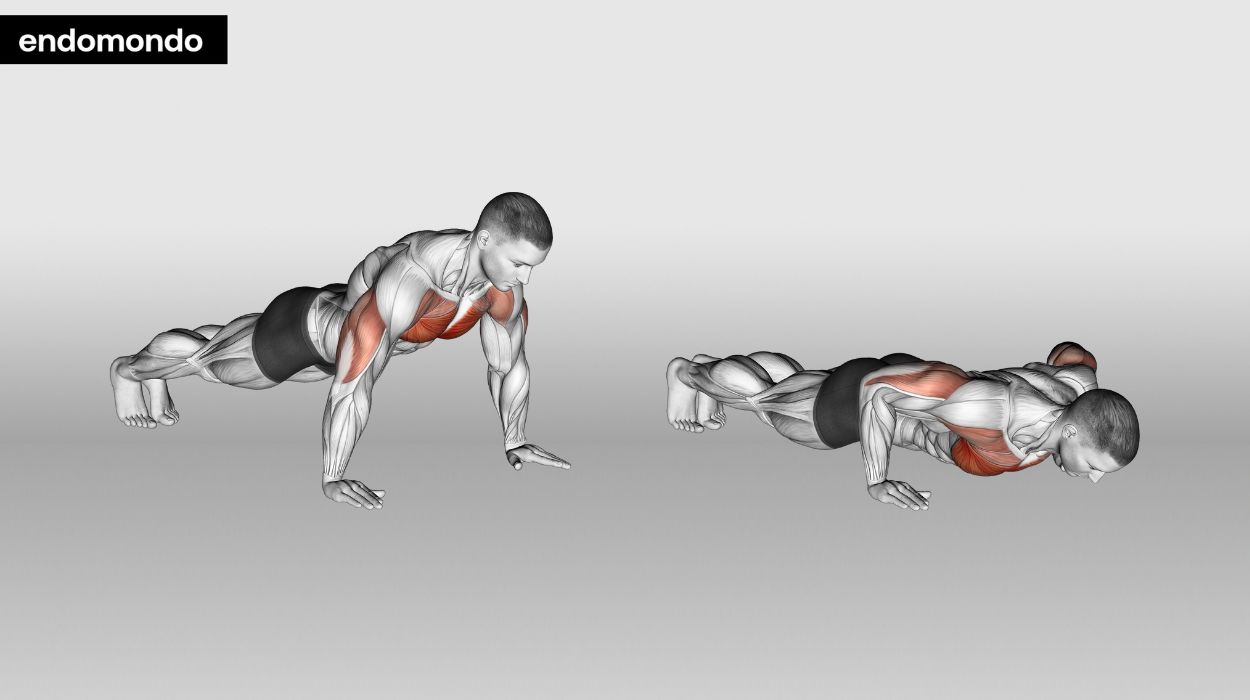
Push-ups are a real staple; timeless, yet ever so effective. Think about it: with every push-up, you’re not just working out your chest. Your shoulders, triceps, and even your core are getting in on the action, making it a complete upper-body routine.
The real charm of push-ups? Their simplicity and how adaptable they are. No fancy equipment? No worries. They fit right into your home workout, with or without additional gear, serving as one of the best bodyweight exercises.
They boost your everyday functional strength, making day-to-day lifting and pushing easier and safer. Plus, they’re a great way to measure your fitness journey and are suitable for everyone, from beginners to pros.
Regularly slotting push-ups into your workout can seriously ramp up your endurance, strength, and body composition. They’re unassuming, but pack a punch, making them an essential piece in your workout puzzle.
How to do:
- Start in a plank position: Place your hands on the ground, slightly wider than your shoulders. Your toes should be set up so that you can balance on your hands and toes.
- Align your body: Ensure your body forms a straight line from your head to your heels. This alignment is crucial for an effective push-up.
- Engage your core: Tighten your abdominal muscles to keep your body rigid throughout the exercise. This engagement is key to maintaining proper form.
- Lower your body: Bend your elbows to slowly lower yourself towards the floor. Aim to get your chest close to the ground without touching it.
- Push up: Exhale as you push back up to the starting position. Focus on using your chest and arm muscles to lift your body.
Tips:
- Keep your body straight throughout the movement so that your head is in line with your spine.
- Engage your core to maintain form.
- Focus on a full range of motion.
- Modify by dropping to your knees if needed.
- Breathe in on the way down and out on the way up.
Optimal Sets and Reps: 4-5 sets of 10-20 reps, based on ability.
Chest And Shoulder Anatomy
Understanding the anatomy of your chest and shoulders is key to maximizing your workouts. Let’s break it down into manageable insights.
The Chest: More Than Just Muscle
The chest is not just for aesthetics; it’s a powerhouse of strength and functionality. Here’s how its main components contribute:
Pectoralis Major
This large, fan-shaped muscle dominates the chest. It’s involved in many upper-body movements, such as pushing and lifting.
Strengthening the pectoralis major improves upper body muscle mass and functional abilities. This includes activities like pushing heavy doors or performing a chest press.
Pectoralis Minor
Though smaller, this muscle lies beneath the pectoralis major and is key to several movements. Picture the pectoralis minor as your body’s hidden support system. It’s the muscle that keeps your shoulder blades steady and composed.[4]
This might not sound glamorous, but it’s crucial when you’re pulling something toward you or reaching up to grab that item on the top shelf. You’re not just dodging potential shoulder troubles by giving this muscle the attention it deserves. You’re also working towards a more upright, confident posture.[5] It’s particularly beneficial if you’re often at a desk, countering that all-too-common slouch and keeping your upper body aligned and strong.
Each chest muscle plays a vital role, not just in enhancing appearance but in empowering your day-to-day activities. A well-rounded shoulder and chest workout isn’t just about building size; it’s about enhancing overall functional strength and stability.
The Shoulders: A Complex Network
The shoulder muscle group plays a crucial role in a range of daily movements. Here’s a closer look at their key components:
Deltoids
These are the highlights of your shoulder anatomy. Think of your deltoids as a trio of muscle heroes, each with a special mission.
The anterior (front) lifts your arms forward – imagine reaching out to grab something. The lateral (middle) is all about lifting your arms out to the sides – like a bird spreading its wings. And the posterior (rear delts)? It’s the muscle that pulls everything back, helping you reach behind.
Strengthening these segments with rear delt exercises is like tuning a well-coordinated muscle orchestra. It’s not just about getting that broad-shouldered look. It’s about making everyday actions – lifting, pushing, and even fun activities like swimming – feel smoother and more efficient.
Rotator Cuff
A group of muscles and tendons surrounding the shoulder joint, the rotator cuff is vital for stability.[6] It keeps your arm bone in the shoulder socket, ensuring smooth and safe movements.
Strengthening the rotator cuff is essential for injury prevention, particularly for athletes or those engaged in repetitive arm movements. It’s also crucial for everyday tasks that require arm rotation, like reaching overhead or behind.
Understanding these shoulder muscle group components and their functions enables you to create a more effective and balanced workout regimen. This knowledge helps prevent injuries and ensures a harmonious development of strength and flexibility in the upper body.
Working Together
Your chest and shoulder muscle groups work in tandem. Understanding the synergy of each muscle group and how it interacts with the others helps craft workouts that are effective and safe. This knowledge isn’t just academic; it’s practical. It guides you in selecting exercises that enhance both strength and stability.
Benefits Of Strengthening Your Chest And Shoulders
When you invest time in strengthening your chest and shoulders, the rewards extend far beyond the gym. Here’s what you gain:
- Better Posture, Better Presence: Strong chest and shoulder muscles help straighten your posture.[7] It’s not just about looking confident; it’s about reducing backaches and neck strains.
- Easier Daily Tasks: Imagine lifting, pushing, and carrying with less effort. Stronger muscles make these everyday actions smoother, reducing the strain on your body.
- Less Risk, More Stability: A fortified upper body guards against injuries. It’s about keeping your shoulders and back safe, especially as you age.
- Strength That Spills Over: Improvements here don’t stay confined. They boost your performance in a range of other activities, from sports to simple home exercises.
- A Look That Speaks Volumes: There’s an undeniable appeal in a well-sculpted upper body. It’s not vanity; it’s about feeling good in your skin.
- Confidence That Grows: As your strength builds, so does your self-assurance. It’s a journey that shapes both your body and your mind.
Each session brings you closer to these benefits. It’s not just exercise; it’s a step towards a more capable, confident you.
Warm-Up And Injury Prevention Tips
Starting your workout right is as essential as the workout itself. Here’s how to gear up and guard against injuries:
- Ease Into It with Dynamic Moves: Begin with action-packed warm-ups like brisk walking or gentle arm swings. They get your blood flowing and muscles ready,[8] reducing unwanted sprains and pulls.
- Stretch on the Flip Side: Save the deep, static stretches for after your workout. It’s the cool-down your muscles crave, helping them relax and recover.
- Gradual Intensity is the Trick: Start with lighter weights or fewer reps. As your muscles warm up, gradually up your game. It’s not just safer; it helps your body adapt and respond better.
- Your Body Talks, So Listen: If it hurts, pause and check in with yourself. Ignoring pain can sideline you longer than you’d like.
- Rest Isn’t Lazy, It’s Smart: Think of rest days as part of your training. They give your muscles the time they need to rebuild and strengthen.
- Fuel and Hydration are Your Friends: Drinking water and eating balanced meals aren’t just good habits. They’re your body’s support system, helping you perform better and recover faster.
Remember, good warm-up and mindful practices are your best allies in keeping your fitness journey enjoyable and injury-free.
Conclusion
As you blend these chest and shoulder routines into your life, think of each session as more than just a workout. The journey is about balance and muscle growth, not just in your muscles but in your personal strength and resilience.
Mixing up routines, like incorporating cable shoulder workouts, keeps it exciting and challenging. Each day, with each set and rep, you’re not just sculpting your body; you’re crafting a lifestyle that’s robust, confident, and full of vitality.
Embrace this path with patience and stay committed to your goals. The transformation you’ll experience goes far beyond the mirror; it extends to the newfound energy and positivity in your daily life.
Frequently Asked Questions
Yes, combining chest and shoulder workouts can be efficient and effective as they often work synergistically in many exercises.
The best workout varies individually, but a combination of presses, flyes, and raises provides a comprehensive approach.
Exercises like the standing barbell military chest press and lateral dumbbell raises complement chest workouts well.
Yes, as long as you allow adequate rest and recovery for the muscles between workouts.
This refers to a workout method where you perform 6 reps of a heavy exercise, 12 reps of a moderate one, and 25 reps of a light exercise consecutively.
It depends on your fitness goals. Starting with the chest is common, but if shoulder development is a priority, begin with shoulder exercises.
Resources
-
Rodríguez-Ridao, D., Antequera-Vique, J.A., Martín-Fuentes, I. and Muyor, J.M. (2020). Effect of Five Bench Inclinations on the Electromyographic Activity of the Pectoralis Major, Anterior Deltoid, and Triceps Brachii during the Bench Press Exercise. International Journal of Environmental Research and Public Health, [online] 17(19), pp.7339–7339. doi:https://doi.org/10.3390/ijerph17197339.
- Solstad, T.E., Andersen, V., Shaw, M., Hoel, E.M., Vonheim, A. and Saeterbakken, A.H. (2020). A Comparison of Muscle Activation between Barbell Bench Press and Dumbbell Flyes in Resistance-Trained Males. Journal of sports science & medicine, [online] 19(4), pp.645–651. Available at: https://www.ncbi.nlm.nih.gov/pmc/articles/PMC7675616/.
- Yuri, Vianna, J.M., Guimarães, M.P., Jorge, Hernández-Mosqueira, C., Silva and Marchetti, P.H. (2020). Different Shoulder Exercises Affect the Activation of Deltoid Portions in Resistance-Trained Individuals. Journal of Human Kinetics, [online] 75(1), pp.5–14. doi:https://doi.org/10.2478/hukin-2020-0033.
- Morais, N. and Cruz, J. (2016). The pectoralis minor muscle and shoulder movement-related impairments and pain: Rationale, assessment and management. Physical Therapy in Sport, [online] 17, pp.1–13. doi:https://doi.org/10.1016/j.ptsp.2015.10.003.
- Kim, M.-K., Jung Chul Lee and Yoo, K.-T. (2018). The effects of shoulder stabilization exercises and pectoralis minor stretching on balance and maximal shoulder muscle strength of healthy young adults with round shoulder posture. Journal of Physical Therapy Science, [online] 30(3), pp.373–380. doi:https://doi.org/10.1589/jpts.30.373.
- Akhtar, A., Richards, J. and Monga, P. (2021). The biomechanics of the rotator cuff in health and disease – A narrative review. Journal of Clinical Orthopaedics and Trauma, [online] 18, pp.150–156. doi:https://doi.org/10.1016/j.jcot.2021.04.019.
- Kim, D., Cho, M., Park, Y. and Yang, Y. (2015). Effect of an exercise program for posture correction on musculoskeletal pain. Journal of Physical Therapy Science, [online] 27(6), pp.1791–1794. doi:https://doi.org/10.1589/jpts.27.1791.
-
Park, H.-K., Jung, M.-K., Park, E., Lee, C.-Y., Jee, Y.-S., Eun, D., Cha, J.-Y. and Yoo, J. (2018). The effect of warm-ups with stretching on the isokinetic moments of collegiate men. Journal of exercise rehabilitation, [online] 14(1), pp.78–82. doi:https://doi.org/10.12965/jer.1835210.605.




